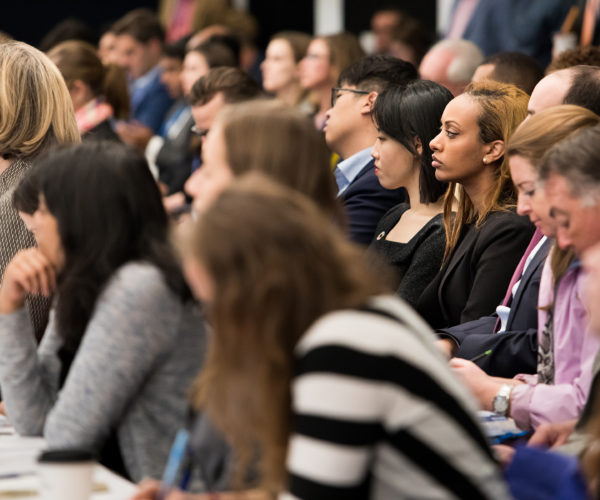When the conversation turns to impact investing, the focus is often on impact venture capital. But, venture capital represents just a small portion of the investment landscape. From public equities and fixed income to alternatives and beyond, asset owners are asking how they can integrate impact across all of their investments. And, students are recognizing the need to get comprehensive training beyond early-stage venture capital if they want more career opportunities in impact investing.
That’s why Wharton Social Impact Initiative and the Good Capital Project launched the Total Impact Portfolio Challenge (TIPC). Sponsored by Bank of America during this inaugural year, TIPC is an academic-year program and annual competition for students to gain practical experience in aligning investment portfolios to financial and social impact goals. It’s not just about venture capital — it’s about the whole investment landscape.
“Greater numbers of college and graduate school students are expressing interest in learning how to be tomorrow’s leaders in sustainable investing,” said Jackie VanderBrug, head of sustainable and impact investment strategy in the Chief Investment Office for Merrill and Bank of America Private Bank. “Demand continues to grow for investments that achieve both financial and social returns. We are delighted to offer our support to students interested in learning how to meet investors’ evolving needs.”
How It Works
Students from graduate schools all over the U.S. apply to the program and form small teams in the fall. In the inaugural 2018-2019 cycle, nearly 140 students hailing from over 15 universities including Columbia University, the University of Pennsylvania, and the University of Hawaii joined the program.
The challenge? To create a “100% impact portfolio” for a hypothetical client — either a family office or private foundation — and demonstrate how the portfolio meets the investor’s impact goals, financial return goals, target asset allocation, and risk tolerance.
Students spend the school year identifying specific securities, funds, and investments to include in their client’s portfolio. They submit their final portfolio as well as a clearly communicated strategy detailing their approach in early March. Finalists are selected in late March and are invited to present their pitch at the Total Impact Philadelphia conference.
By participating in the program, students benefit by putting classroom theory into practice, getting exposure to real-world investing opportunities, and learning how to embed impact into overall strategic asset allocation.
2019 Finals
This year, the five finalist teams hailed from Boston University, Columbia, Fordham, Yale, and the University of Vermont. The finalist teams’ submissions showed creativity and demonstrated a rigorous, methodical approach to portfolio construction. They were also effective in reflecting their client’s impact objectives throughout their selections.

Maura Kalil, Emily Klein, Andrew Mallory, Peter Seltzer, and Alyssa Stankiewicz from University of Vermont’s Sustainable Innovation MBA ultimately won the competition, proposing a 100% impact portfolio that mapped their client’s goals to the UN SDGs (Sustainable Development Goals). They used a new ESG (environmental, social and governance) scoring system in their approach, and expected to achieve a 9.58% return for their client.
“It’s a culmination of a long year’s work and we learned a lot. It was a great experience and we’re happy to take this and move forward with our individual careers,” said Andrew Mallory.
Alyssa Stankiewicz added, “We’re happy to contribute to impact investing as an industry overall and see where it takes the future of finance.”

A student team from Fordham University’s Gabelli School of Business (Yu An, Cezar Aragao, Baoying Huang, Zihan Jiang, and Johanna Woldai) was the first runner-up.
Judges for the 2019 competition included Michael Lear of Alliance Bernstein, Glen Macdonald of Bronfman Rothschild, and Jackie Vanderbrug of Bank of America.
“We were struck by the range of approaches students took to creatively integrate ESG and impact considerations into their portfolio allocation decisions,” said Sharadiya Dasgupta, managing director of Good Capital Project. “They looked at individual holdings of mutual funds and ETFs to dissect ESG scores, studied the use of proceeds of municipal bonds, and scanned the composition of fund management teams to align to gender diversity and inclusion goals.”
She added, “We are hopeful that having gone through this program, participating students will be strongly inclined to apply the sustainability lens in whatever financial roles they pursue next.”
Industry Resources for Students
Of course, it wouldn’t be called a “Challenge” if it weren’t challenging. Creating a “100% impact” portfolio is aspirational, as not all asset classes offer easy-to-find, investable opportunities. Students were encouraged to be creative in their approach and definition of impact.
Luckily, they also had a set of industry resources to help them look for investment opportunities. Toniic, Aapryl and Align Impact served as content partners and supported students through investment tools, webinars, and case studies focused on impact investing.
Students also benefitted from advice from nearly 50 Bank of America mentors — including wealth advisors, portfolio managers, and sustainability experts.
“The Bank of America mentors provided students with a strong link to industry practice,” said Nick Ashburn, senior director at WSII. “It allowed students to get expert feedback from practitioners who face similar challenges when trying to serve their own clients every day.”

Get involved: applications for the 2019-2020 program open in August 2019. Learn more on the Total Impact Portfolio Challenge website.
– Nisa Nejadi
Photos courtesy of Chris Kendig.
Posted: May 3, 2019




















